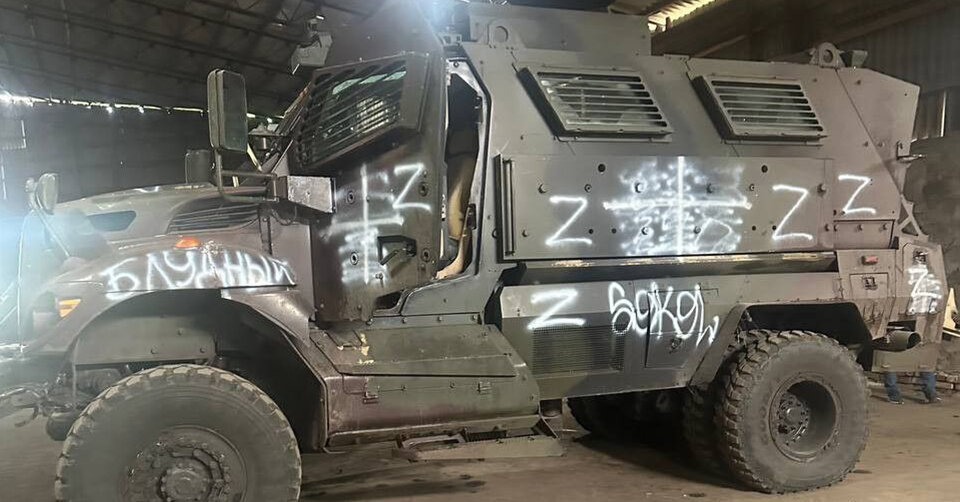Pro-Ukraine fighters appeared to use at least three American-made armored vehicles during an incursion into Russia on Monday, pictures and videos verified by The New York Times reveal.
Russian forces appeared to have captured at least two of those vehicles, additional visual evidence shows. It’s unclear how the pro-Ukraine units behind the incursion, which consist mostly of anti-Putin Russians, came to possess the vehicles — known generally as MRAPs, for Mine-Resistant Ambush Protected. The circumstances that led to the Russians capturing them are also unknown, but pro-Russian Telegram groups began posting pictures of the equipment on Monday night, hours after the incursion started.
The Times identified the vehicles by their markings when they were inside Ukraine and once again after they were in the hands of Russian forces.
MRAPs were first built for U.S. forces in Iraq and Afghanistan, and the United States has provided several hundred to Ukraine’s military. The specific model appears to be International MaxxPros. They have been seen in videos of various front lines around the country.
While numerous countries have purchased and used the vehicles, the United States is the only country known to have specifically sent them to Ukraine.
In one of the posted photos of a seized MRAP, a Russian soldier is standing next to a vehicle with a distinct white spray-painted marking — an upward-pointing arrow. A vehicle with this exact marking was seen in video footage of the attacking forces about five miles from the border just hours before their incursion into Russia.
A photo of another vehicle apparently seized by Russia, first posted online over the last 24 hours, featured details — white plus signs — that were on many other vehicles that appeared in posted images of the attack inside Russia.
A third MaxxPro with similar markings appears in a short video showing a pro-Ukrainian soldier in the village of Glotovo, about two miles into Russian territory.
A U.S. official said the government had seen reports on social media that the vehicles were used in the incursion and was continuing to examine them to determine if they were accurate.
“I will say that we’re skeptical at this time of the veracity of these reports,” said Matthew Miller, a State Department spokesman. He reiterated that the United States did not “encourage or enable strikes inside of Russia, and we’ve made that clear.”
“But as we’ve also said,” he added, “it is up to Ukraine to decide how to conduct this war.”
The use of U.S. military equipment on Russian soil could strain relations between Ukraine and the United States, which has given Ukraine tens of billions of dollars in military aid, with one of the conditions being that it not be used to attack Russia within its own borders.
Photos and videos showed dozens of pro-Ukraine fighters using the vehicles in their convoy as they crossed the Russian border into the village of Kozinka on Monday morning. The Ukrainian military’s involvement in the operation is not clear.
While there have been attacks over this border during the 15 monthlong war, Monday’s assault was unique in its brazenness and duration. The two units that claimed responsibility for the incursion are the Free Russia Legion and the Russian Volunteer Corps, which are made up of Russian nationals who have been fighting in Ukraine against the Russian military.
Russia has cast members of the assault force as Ukrainian militants and saboteurs; Ukraine’s deputy defense minister, Hanna Maliar, called them “Russian patriots” participating in an “internal Russian crisis.”
The Free Russia Legion is part of a unit overseen by Ukrainian officers, but Mykhailo Podolyak, a presidential adviser, said Ukraine had nothing to do with the incursion.
The assault into Russia has stretched into its second day. On Tuesday afternoon, Russia’s Ministry of Defense said it had pushed the fighters back over the border, but people who claim to represent the groups maintained that they were continuing attacks in Russia.
The incursion came days after a Friday announcement that President Biden agreed to allow Ukrainian troops to be trained on F-16 warplanes and was open to other countries supplying them to Ukraine, a reversal after a year of denying Ukrainian requests for the aircraft over concerns it could be used to strike targets within Russia and potentially escalate the conflict.
Christoph Koettl, Dmitriy Khavin and Julian Barnes contributed reporting.


